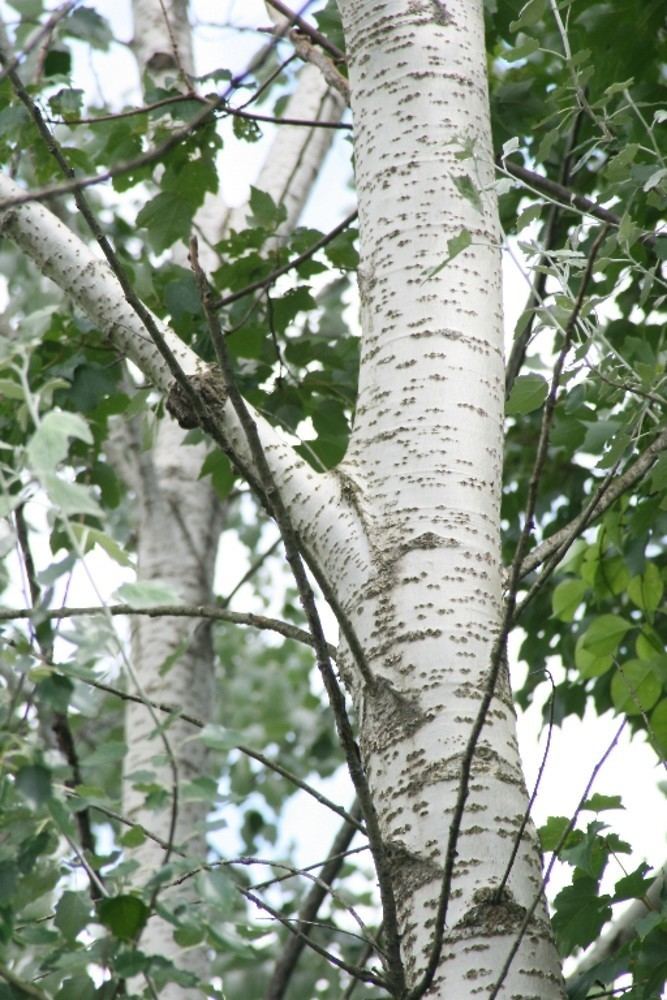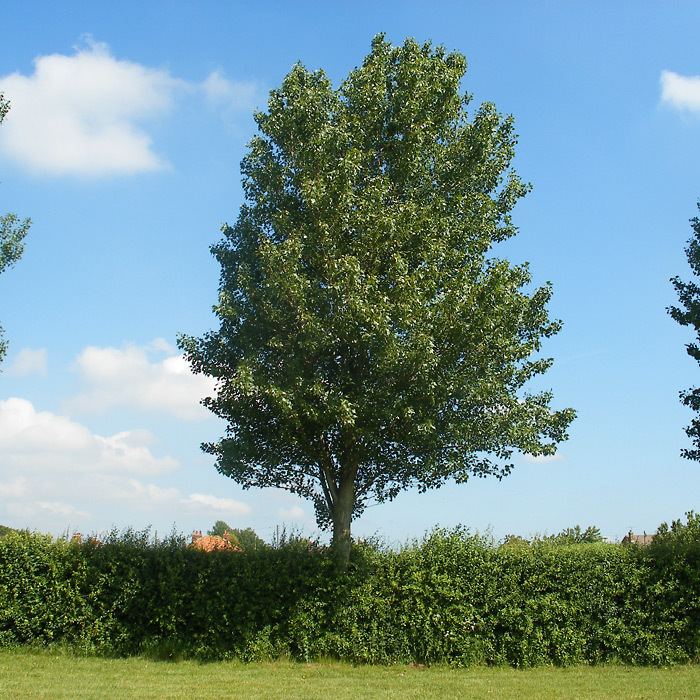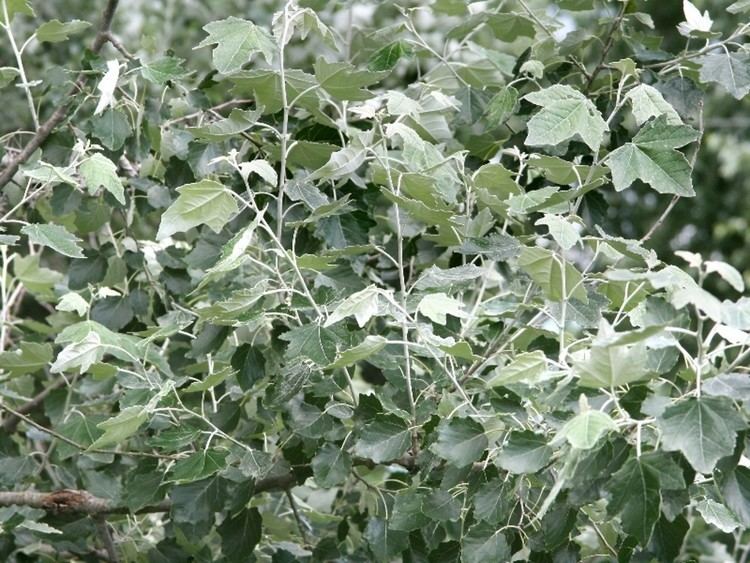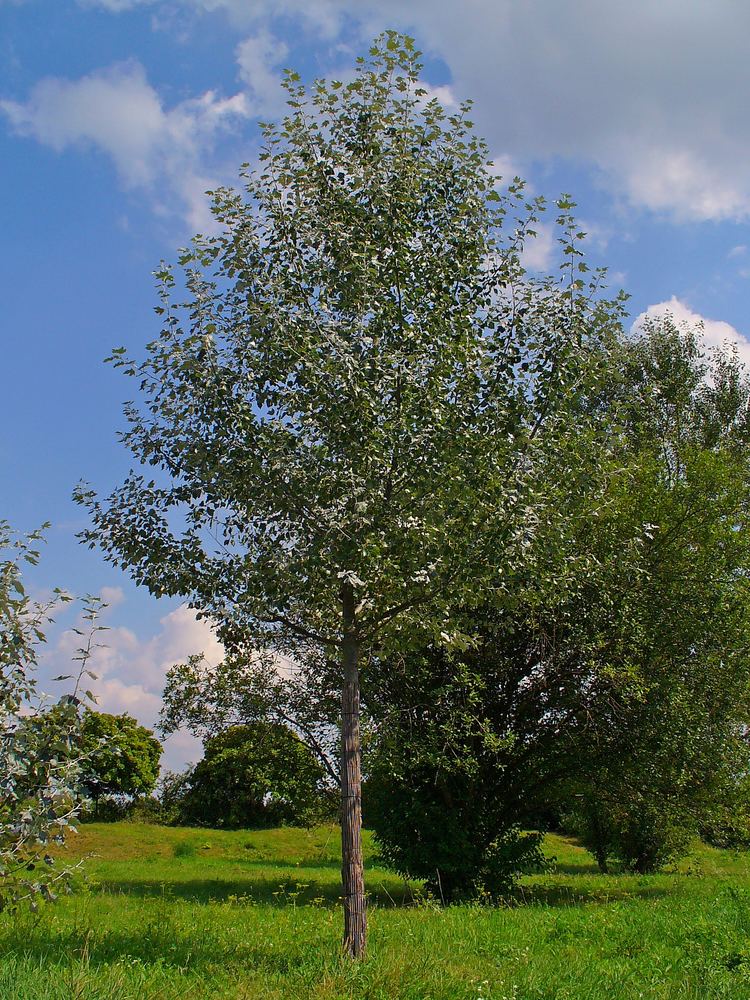Higher classification Cottonwood | Genus Populus Scientific name Populus alba Rank Species | |
 | ||
Similar Cottonwood, Populus nigra, European aspen, White willow, Alnus glutinosa | ||
Populus alba
Populus alba, commonly called abele, silver poplar, silverleaf poplar, or white poplar, is a species of poplar, most closely related to the aspens (Populus sect. Populus). It is native from Morocco and the Iberian Peninsula through central Europe (north to Germany and Poland) to central Asia. It grows in moist sites, often by watersides, in regions with hot summers and cold to mild winters.
Contents

Description

It is a medium-sized deciduous tree, growing to heights of up to 16–27 metres (52–89 ft) (rarely more), with a trunk up to 2 metres (6.6 ft) in diameter and a broad rounded crown. The bark is smooth and greenish-white to greyish-white with characteristic diamond-shaped dark marks on young trees, becoming blackish and fissured at the base of old trees. The young shoots are covered with whitish-grey down, including the small buds. The leaves are 4–15 cm (1 1⁄2–6 in) long, five-lobed, with a thick covering of white scurfy down on both sides but thicker underneath; this layer wears off the upper side but not the lower, which stays white until autumn leaf fall. Larger, deeply lobed leaves are produced on fast-growing young trees, and smaller, less deeply lobed leaves on older, slow-growing trees. The flowers are catkins up to 8 cm (3 1⁄4 in) long, produced in early spring; they are dioecious, with male and female catkins on separate trees; the male catkins are grey with conspicuous dark red stamens, the female catkins are greyish-green. The female catkins lengthen to 8–10 cm (3 1⁄4–4 in) after pollination, with several green seed capsules, maturing in late spring to early summer. It also propagates by means of root suckers growing from the lateral roots, often as far as 20–30 m (65–100 ft) from the trunk, to form extensive clonal colonies.
Hybridization

White poplar hybridises with the closely related Common Aspen Populus tremula; the resulting hybrid, known as grey poplar (Populus × canescens), is intermediate between its parents, with a thin grey downy coating on the leaves, which are also much less deeply lobed than White Poplar leaves. It is a very vigorous tree with marked hybrid vigour, reaching 40 m (130 ft) tall and a trunk diameter over 1.5 m (4 ft 11 in), much larger than either of its parents. Most Grey Poplars in cultivation are male, but female trees occur naturally and some of these are also propagated.
Cultivation and uses

White poplar requires abundant light and ample moisture, and stands up well to flood water and slightly acidic soils. Its green-and-white leaves makes it an effective ornamental tree but the root suckers may cause problems in some situations. It is very attractive as an open-grown tree in water meadows, and, because of its extensive root system and tolerance of salt, is also planted to strengthen coastal sand dunes.
The majority of White Poplars in cultivation in northern Europe are female trees.

White poplar was first introduced to North America in 1748 and has a long history in cultivation. It is now found in forty-three states throughout the contiguous U.S. It has come to be considered weedy or invasive; it has been banned in Connecticut and is the most common introduced tree species on Cape Breton Island.

In US intensive forest management it is being replaced by various Populus sect. Aigeiros hybrids. The wood is soft, and used to for cellulose and to make cheap boxes.
A conical cultivar from Turkestan, Populus alba 'Pyramidalis' (Bolle's Poplar; syn. Populus bolleana) is sometimes planted in parks.
Sculpture
The wood is soft but close-grained and easy to carve, shrinking very little during seasoning. It has been used for sculpture from Europe to China and the US. The Penitent Magdalene by Donatello is one 15th-century example.
History
An old English name "Abele", now rarely used, is derived from the Latin albellus, white, by way of Old French aubel and Low German name abeel.
According to ancient Roman mythology the White Poplar was consecrated to Hercules because he destroyed Cacus in a cavern adjoining the Aventine Hill, which was covered with these trees; and in the moment of his triumph he bound his brows with a branch of White Poplar as a token of his victory. Persons offering sacrifices to Hercules were always crowned with branches of this tree; and all who had gloriously conquered their enemies in battle wore garlands of it, in imitation of Hercules. Homer in the "Iliad" compares the fall of Simoisius when killed by Ajax to that of a poplar.
So falls a poplar that on watery ground
Raised high its head with stately branches crowned.
Ovid mentions that Paris had carved the name of Ænone on a poplar, as Shakespeare has Orlando carve the name of Rosalind upon the trees of the forest of Arden.
Virgil gives directions for the culture of this tree and Horace speaks of the White Poplar as delighting to grow on the banks of rivers.
Weed Potential
The white poplar is an invasive species in many parts of Australia. In Western Australia it has formed dense stands in disturbed wetlands from Perth to Albany and it is considered a threat to riparian vegetation in Victoria. It has spread along the Murrumbidgee River and in wet areas in rural parts of the ACT. Despite that, it is still sold in nurseries around Australia. White poplar is also an environmental weed in South Africa.
